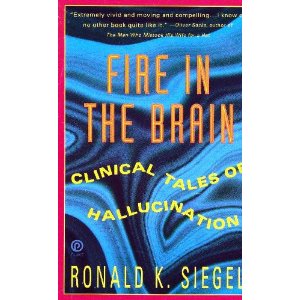Review: Fire in the Brain October 18, 2014
Author: Beach Combing | in : Actualite, Contemporary , trackbackFire in the Brain: Clinical Tales of Hallucination dates back to 1992, yet it is by far the best introduction to visions and perception and misperceptions known to this blogger. The author Ronald K. Siegel offers seventeen case studies, where he had investigated people who saw things that were apparently not there. We have, for example, the nurse who stumbles on ghostly swastikas in the hospital linen, the adolescent girl who speaks about sex and desire with a dragon called Chopsticks, there is a striking UFO experience, there is a lunatic cocktail of cocaine and a sea storm, there is the marijuana grower who channels his dead daughter… Siegel sets out to understand why people see what they see: for example, the nurse works the night shift and she never sees the swastikas the first night back on work after the weekend, when she had caught up with her sleep. Siegel decides that she is suffering from extreme sleep deprivation, with caffeine uppers blocking her REM and is (essentially) dreaming while awake. He has though to follow her around for a week to get to the bottom of the problem and almost kills himself in the process. Most of the seventeen case studies unwind like a detective stories with the hallucination being the murder. The whodunit becomes a question of which neuron or drug (accidentally or deliberately digested) creates the man walking into the room with his face melting. For Beach Siegel’s book links into a particular fascination, why people claim to see fantastic humanoids (mermaids, fairies, bigfoots etc). Are they best explained as these kinds of freak neurological events? Siegel would certainly say so. He is apparently a pure materialist. The title recalls Yeats ‘I went into a hazel wood, because a fire burnt in my head…’, but it is fire in the brain. Siegel claims to see the cogs turning and he even confesses to a certain monotony in dealing with the predictable nature of, say, LSD trips. Beach would have a lot of sympathy with this way of looking at things. But there is a deeper problem. If the brain does create images, what do these images mean? One Mexican shaman tells Siegel that peyote does not bring hallucinations only truth. Are we, in these images, connecting, elaborating, understanding some deeper source then? Or are we just channelling the depressing static of the human subconscious, cerebral white noise? In short, does the created create or masturbate? Other books on hallucinations, visions, etc: drbeachcombing AT yahoo DOT com
PS I’ve taken the unusual step of pdf-ing a first chapter to try and convince friends to buy this book. I’ve put it up here risking the hate of the gods of copyright. Hopefully more books will be sold, dear gods, do not loose your bolts on me… siegel fire in the brain chapter 1



